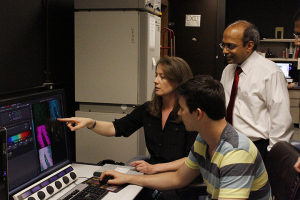If you’ve ever lived through a hangover, you are probably already familiar with the unpleasant, lingering side effects that a night of binge drinking can have on the brain: when you wake up the next day, the sunlight seeping through your window burns your retinas, your brain feels like it’s coated with goo and it’s impossible to focus, let alone think.
But what if hitting the gym prior to hitting the bars could make your hangover the next morning a little less painful? Or, at the very least, what if exercise has a neuro-protective effect, reducing the negative (and oftentimes long-term) effects that binge drinking has on the brain? That’s what ECE chair Badri Roysam is trying to find out in a research collaboration with a UH psychology faculty member.
The collaboration with associate professor Leigh Leasure involves the analysis of 3-D images of brain tissues from animal models using Roysam’s FARSIGHT software suite. This is a quantitative histopathology tool that can be used to analyze tissue images to identify and quantify cell and tissue alterations caused by binge alcohol consumption, pre- and post-binge exercise, and potential protective drug treatments.
While Leasure has spent much of her career studying the brain in different states and its response to different stimuli, FARSIGHT will enable investigations that are much broader as well as much deeper. While many of her earlier research efforts had to target specific cell or tissue types, “the power of FARSIGHT is to get very precise measurements on many different tissue parameters. We can look at everything from the size of neurons, the number of glia, and the proximity of glial cells to vasculature,” she said.
In addition, “we can do hypothesis testing. We can look and see if what we think is going to happen is actually happening. And we can do exploration. What else is going on that we don’t know about? We’ve never had the potential to look at things in a global fashion before.”
While their initial work will focus on alcohol and exercise, Leasure and Roysam plan to expand their collaboration to include the study of multiple brain states, including neurodegenerative diseases and aging.
One particular area of interest in all these studies will be the brain’s blood vessels and its glial cells, which help maintain chemical balance in the brain and aid in communication among neurons. The glial-vascular complex, said Leasure, is key to supporting the health of neurons. And since glia and vasculature regenerate (while neurons typically don’t) they should in many ways be easier to influence, making them good targets for future therapies and medications.
